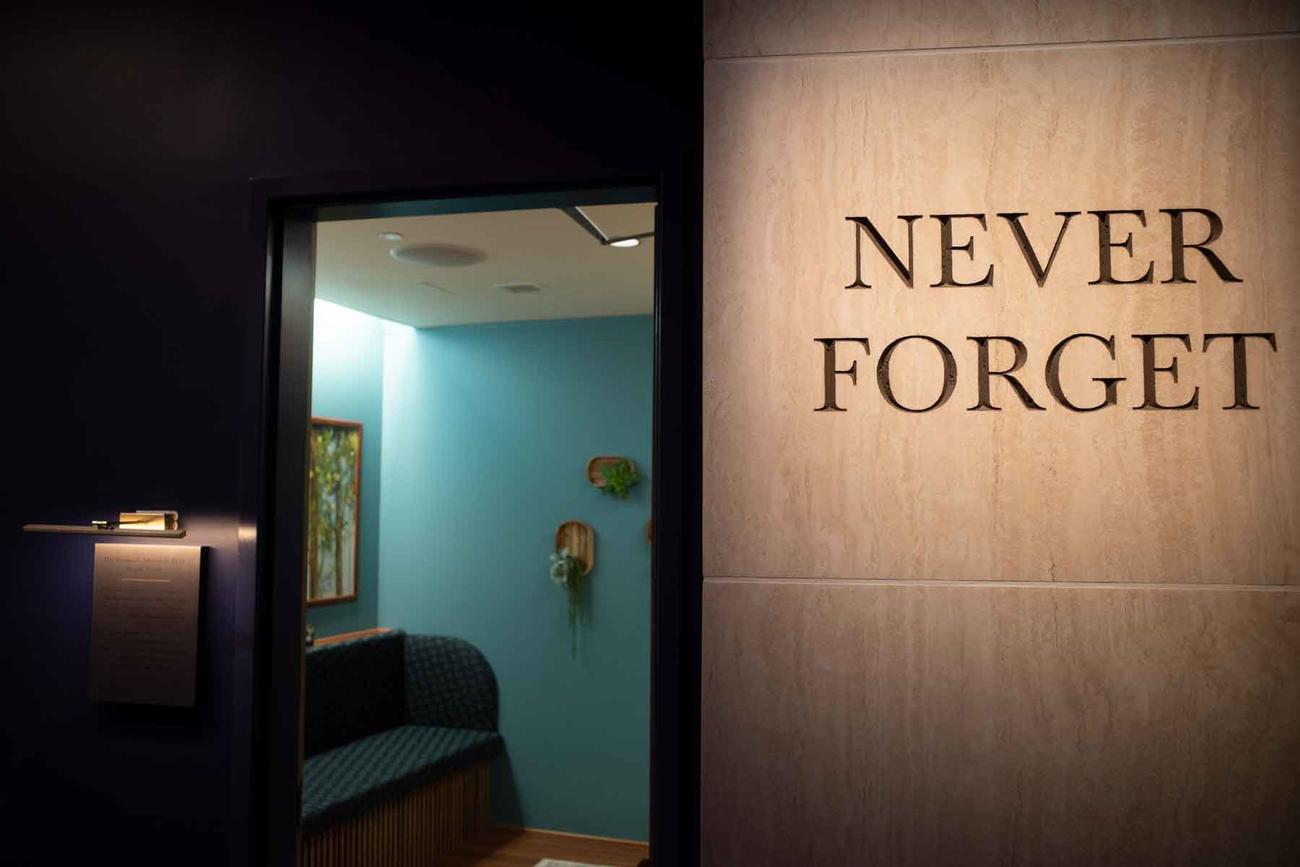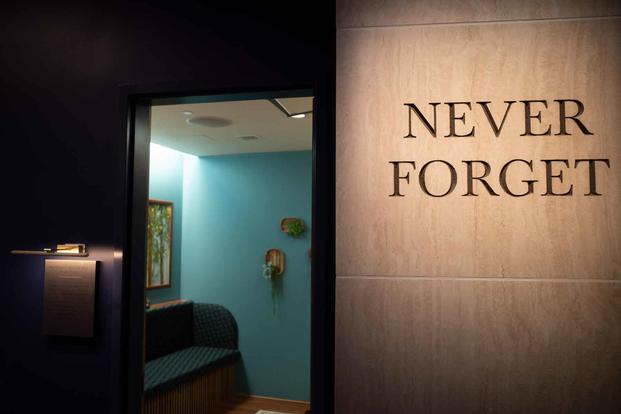

Next to the upcoming Global War on Terror exhibit at the National Museum of the Marine Corps in Virginia, there is now a quiet place for veterans to reflect and find respite from images and artifacts in the museum that may evoke stressful memories of combat and military service.
The respite room, as officials dubbed it, was unveiled Wednesday in front of a crowd of roughly 100 people, including veterans, Marines, sailors and loved ones celebrating the commemoration of a yearslong effort to bring the space to reality — and further a still-difficult conversation about the effects of post-traumatic stress.
The idea for the respite room was born in 2019 when a retired Marine Corps major general, James Kessler, asked Ron Zaczek, a decorated Vietnam veteran and helicopter crew chief, and his wife Grace to create a space for veterans like Ron — who experienced post-traumatic stress from their time in combat — to find a moment of peace.
Read Next: Army Warns Troops to Be Wary of Job Offers as China Wages Subtle Intel-Gathering Campaign
The couple jumped at the chance to continue the “mission of keeping our Marines safe in their home,” Grace said. Ron, who authored two books about his combat experience, passed away early last year. Pictures of him during and after his military service temporarily adorned the respite room in his honor.
Partially quoting Pulitzer Prize-winning author Viet Thanh Nguyen, Grace said, “All wars are fought twice — the first time on the battlefield, the second time in memory.
“Enemies change, battlefields and weapons change,” she said. “The effects and consequences of combat trauma for veterans and their families never change.”
Grace cut the ribbon to the room during its christening at the museum in Triangle, Virginia.
A Place to Reflect, Recover
Once a restroom, the respite room features two comfortable chairs and a long couch. It was adorned with plants that complemented the blue-green color of the walls, which are soundproofed against any commotion outside. Calming music placidly filled the room, and veterans and family members had the option to dim the lights.
Notably, outside of Ron’s two books between the two chairs, there are no military artifacts or memorabilia in the room — or any reminder of the outside world at all.
Dr. Terence Keane, the director of the National Center for Post-Traumatic Stress Disorder, Behavioral Science Division, told Military.com after the ceremony Wednesday that the room is meant to help relieve not only the mental effects of post-traumatic stress possibly triggered by the exhibits in the museum, but the physical ones.
He said that when those who have post-traumatic stress are reexposed to “cues,” it can elicit an elevated heart rate, sweating and increased blood pressure.
The respite room is a place “to reflect, to speak with somebody else who might be a combat veteran, or who might be a family member or friend in the interest of helping them recover from these very strong, emotional, physical reactions to combat cues,” Keane said.
Officials at the ceremony said they hope other museums across the country will adopt a similar approach. Not only is the room intended to provide a peaceful place of reflection for those experiencing the effects of post-traumatic stress, it also continues the conversation about the condition overall.
“I think it’s important — this idea of a respite room — just recognizing the need for it,” retired Marine Maj. Gen. James Lukeman told Military.com. “Simply a guest asking, ‘What’s a respite room for?” starts a conversation about post-traumatic stress.”
Those in the room said openness about the topic has improved in the national consciousness, but was long overdue.
“For so long, we didn’t talk about it at all in this country,” Lukeman said. “People still don’t want to talk about it. But we have a very subtle but meaningful and useful way to address it here in the National Museum of the Marine Corps.”
Vietnam Veterans Helped Pave the Way
While the respite room is located just outside of the new Afghanistan and Iraq exhibit, which will open in September, its origins started with the Vietnam era.
In 1980, as the country was just beginning to understand the true aftereffects of the Vietnam War and the term post-traumatic stress disorder made its first appearance in official diagnostic literature, Ron — the Marine crew chief — met Dr. Thomas Murtaugh.
“Some of Tom’s first words to Ron on Ron’s initial visit to the vet center were, ‘You are safe here,'” Grace said.
Murtaugh, for whom the room is dedicated, not only helped Ron heal from his experiences in Vietnam, but started a new age of understanding veteran trauma on a national scale.
As a clinical and research psychologist for the then-Veterans Administration for 24 years, Murtaugh was known internationally for PTSD treatment and created the first outpatient veterans center in Elkton, Maryland, according to his obituary. Murtaugh died in 2013.
He conducted this work alongside Keane, who delivered remarks about the decades-long effort to put PTSD recognition and treatment on the map to the crowd at the museum.
“So, why a room of respite?” Keane asked the crowd. “Because the cues of combat, the cues of war and their indelible impacts last forever. The good news is that post-traumatic stress disorder does not have to last forever.”
Keane has spent more than 40 years researching the effects of PTSD, and in 1985 managed the National Vietnam Veterans Readjustment Study, a bedrock academic effort that put post-traumatic stress among veterans in the spotlight across the country and around the world.
“The idea was to demonstrate convincingly that post-traumatic stress disorder existed,” he said. “Can you imagine that in 1985 — in our lifetimes — there would be very significant challenges as to whether or not war and other traumatic events lead to long-lasting psychological distress? But that’s true.”
He said that, out of that study, 15% of men were still experiencing PTSD 20 years after the war; for women who had served in that time frame, 9% had PTSD.
“Both groups of people, whether they were caring for the dead or the injured, or they were fighting the wars, had experienced PTSD,” he said.
New Focus on Trauma
But the study, which continued into the ensuing decades, also offered a beacon of hope. The research team contacted respondents of the study decades after the war and found that one-quarter of the veterans who reported PTSD had recovered, either on their own or through psychotherapy.
The study not only broadened the understanding of combat experiences, Keane said, but of trauma overall. From domestic violence, community violence and industrial and motor vehicle accidents to sexual assault and rape, the study opened the country’s aperture to the long-lasting effects of trauma, he explained. In the ensuing years, vet centers were created, and PTSD clinical teams became a fixture at VA hospitals across the country.
Murtaugh did not live to see the full outcomes of that study, Keane said, but when it came time to decide to whom the new area to supply solace within the halls of the Marine Corps museum should be dedicated, there was no question.
“His work had an impact,” Keane said. “The impact was to soothe the people who’d experienced some of the worst things that life has to offer.
“And this room, here open indefinitely into the future, will be a respite for those people who experienced war trauma or other forms of violence and abuse,” he continued, “and who need to sit for a moment and reflect on their own life experiences. And then move forward.”
